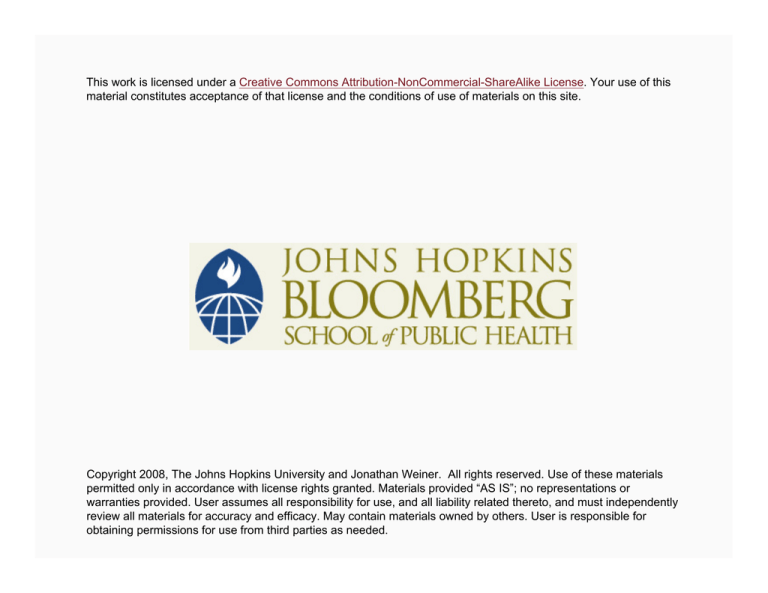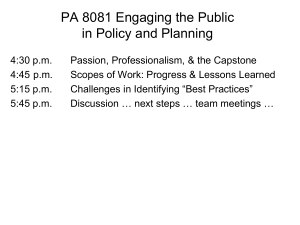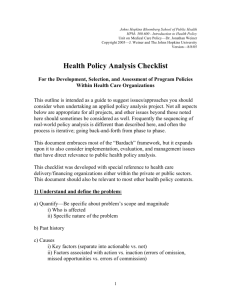
This work is licensed under a Creative Commons Attribution-NonCommercial-ShareAlike License. Your use of this
material constitutes acceptance of that license and the conditions of use of materials on this site.
Copyright 2008, The Johns Hopkins University and Jonathan Weiner. All rights reserved. Use of these materials
permitted only in accordance with license rights granted. Materials provided “AS IS”; no representations or
warranties provided. User assumes all responsibility for use, and all liability related thereto, and must independently
review all materials for accuracy and efficacy. May contain materials owned by others. User is responsible for
obtaining permissions for use from third parties as needed.
Health Policy and the Delivery of Health Care: Case
Study Continuation and Placing Policy Analysis in
Context
Jonathan P. Weiner, DrPH
Johns Hopkins University
Lecture Objectives
To continue our “U-Care” case study
Per your homework assignment, we will have an individual
exercise that focuses on
− Decision criteria (#4 in expanded Bardach policy analysis
framework)
3
Lecture Objectives (Continued)
Close out our case study by discussing
− Estimating impact (#5)
− Decision-making process (#6)
− Advocacy (#7)
− Implementation, improvement, evaluation (#8)
Place the Bardach policy analysis approach into broader
context
4
Section A
Review and Continuation of Case Study
Beyond Bardach
Expanded Bardach
framework
1. Understand/define problem
2. Obtain evidence/data
3. Alternative solutions
4. Develop “criteria” matrix
5. Estimate impact (outcome)
of policy
6. Decision process (consider
trade-offs)
7. Advocate chosen policy
8. Implement, improve, evaluate
(“Beyond Bardach”)
Standard eight-step Bardach
policy framework
1. Define the problem
2. Assemble some evidence
3. Construct the alternatives
4. Select the criterion
5. Project the
outcomes
6. Confront the
trade-offs
7. Decide
8. Tell your story
6
“U-Care” Case Study
The application of public health policy principles and
methods within a private not-for-profit organization
responsible for the health of 200,000 persons
7
Our Task Regarding Cardiovascular Disease
Review of our task
− To develop appropriate
organizational policies that
address key problems related
to the treatment of persons
with cardiovascular disease
X Specifically,
hypertension (high
blood pressure) and
hyperlipidemia (fatty
arteries)
Problems
− Many among our population
are not receiving adequate
care for early-stage
cardiovascular disease
I. Majority or our members
with early-stage
disease are not under
treatment
II. For about 50% of the
patients under care,
“process of care”
standards not being
met (e.g., lipid
screening,
recommended drug
regimen)
8
Two Policy Alternatives to Be Considered
1. Comprehensive “community” outreach program involving
− Member education (not just patients)
− Screening program for all members
2. Aggressive “disease management” program focusing on
− Improved administrative systems
− Changing provider practices (using performance-based
rewards and penalties)
− Patient compliance interventions
9
Individual Exercise
Developing decision criteria (turn to step #4 on handout)
− For each of the five points (#4a–e on the handout),
develop at least one practical criterion for possible
inclusion in your final decision matrix
X Remember, this criteria list is generic and should be
applicable to both policy alternatives
X Take 15 minutes for this exercise
X We will discuss the “correct” answers during the
LiveTalk
10
OK, Time’s Up—Let’s Debrief
I am the director of policy, planning, and evaluation at U-Care
This is a meeting of senior staff from all units across our
organization
11
Let’s Review Outcome of ”Criteria” Exercise
a) Population benefit
− End results/outcomes
− Evidence-based care process standards
− Access
− Disparities
12
Let’s Review Outcome of ”Criteria” Exercise
a) Population benefit
− End results/outcomes
− Evidence-based care process standards
− Access
− Disparities
13
Let’s Review Outcome of ”Criteria” Exercise
a) Population benefit
− End results/outcomes
− Evidence-based care process standards
− Access
− Disparities
b) Cost/economics
− Cost benefit
− Efficiency
− Cost containment
14
Criteria (Continued)
c) Ethics/equity
− “Total good” vs. individual rights
− Fairness in distribution of resources
15
Criteria (Continued)
c) Ethics/equity
− “Total good” vs. individual rights
− Fairness in distribution of resources
d) Feasibility
− Organizational control and time frame
− Resources
− Simplicity/chances of success
− Legal/regulatory
16
Criteria (Continued)
e) Constituency perspectives
− Providers
− Sponsors (employers, Medicaid)
− U-Care staff
− Your board and hospital “owners”
− Other?
17
Estimating Impact of Policy Alternatives
OK . . . are there structured evidence-based approaches we
can use to estimate the impact of our policy alternatives
along some of the dimensions we identified?
First, a little “methods review . . .”
18
Section B
Estimating Impact
Estimating Impact: A Brief Methodologic Review
A wide range of analytic techniques can be applied to
estimate impact of policy alternatives
The goal for today is modest—for two of these tools, we will
open the “black box” a bit, and I will discuss the range of
techniques available
We hope you will continue your studies so you will learn how
to apply these techniques on your own
20
Examples of Quantitative Estimation Approaches
Simulation (operations research—OR)
− Linear programming
− Monte Carlo simulations
− Markov models
− Decision trees
− Forecasting/predictive modeling
− Bayesian/risk analyses
See required/extra readings on e-reserve
− Owen (2002)
− Barton (2004)
21
Examples of Quantitative Estimation Approaches
Simulation (operations research—OR)
− Linear programming
− Monte Carlo simulations
− Markov models
− Decision trees (see next slide)
− Forecasting/predictive modeling
− Bayesian/risk analyses
See required/extra readings on e-reserve
− Owen (2002)
− Barton (2004)
22
Sample Decision Tree
Sample decision tree for assessment of costs and outcomes of
population-based cholesterol screening
Dietary intervention
True +
Maintain
drug treatment
Drug
treatment
Receive total
cholesterol test
Patient has
elevated
cholesterol
(true +)
Survive
Die
Survive
Discontinue
Die
Survive
False –
Die
Survive
Not tested
Die
True –
Patient has normal
cholesterol
(true –)
Receive total
cholesterol test
Dietary intervention
False +
Drug treatment
Not tested
23
Sample Decision Tree
Dietary intervention
True +
Maintain
drug treatment
Survive
Die
Drug
treatment
Survive
Receive total
cholesterol test
Discontinue
Die
Patient has
elevated
cholesterol
(true +)
Survive
False –
Die
Survive
Not tested
Die
True –
Patient has normal
cholesterol
(true –)
Receive total
cholesterol test
Dietary intervention
False +
Drug treatment
Not tested
24
Examples of Economic Estimation Approaches
Cost vs. benefit (CBA)
− Both sides in monetary terms
Cost vs. effect/utility (CEA)—see next 2 slides
− Outcomes in units other than monetary
− Increasing use of “quality/disability adjusted life years”
(QALYs and DALYs)
Fiscal forecasting
See Russell (1996), Goldie (2003), Maynard (2003)
25
CEA: Diet Intervention and CV Risk Factors
See Tables 1 and 2 from Prosser, L. A. et al. (2000). Annals of
Internal Medicine, 132, 769–779.
26
QALYs of Diet Interventions
See Figure 1 from Prosser, L. A. et al. (2000). Annals of Internal
Medicine, 132, 769–779.
27
OK, Back to Our Case Study
What approaches might we use to help estimate impact of
policy alternatives (or their various components)?
28
Estimating Impact/Outcomes
a) Need for phased analyses
− Rarely will there be equal effort on all aspects for every
alternative
b) Learn from others
− Evidence-based literature reviews
− Other programs
29
Estimating Impact/Outcomes (Continued)
c) Quantitative techniques
d) Cost effect or benefit
Can you suggest an example of a decision science, economic,
or other analytic techniques that might be applied to
estimate the effects of the two alternative policy solutions?
What types of outputs might these techniques provide to
support our analysis?
30
Estimating Impact/Outcomes (Continued)
e) Policy formulation research
− Primary data collection to inform estimation analysis
− Evaluate pilot project
f) Expert input
− Group process (Delphi panels)
− Consultants
− Commission policy development study
31
Making the Decision
a) Advisory group
b) Translate criteria into decision matrix (see appendix of
handout)
− Determine relative “weight” of each
c) Quantitatively “score” each policy alternative for each criterion
32
Making the Decision
a) Advisory group
b) Translate criteria into decision matrix (see appendix of
handout)
− Determine relative “weight” of each
c) Quantitatively “score” each policy alternative for each criterion
d) Integrate and step back
− Sensitivity analysis (modify criteria, weights, or scores)
− Combine/modify alternatives
− Involve organizational leadership
e) Finalize internal decision memo
33
Sample Decision Matrix
Screening
outreach
(Score: 1–10)
Disease
management
(Score: 1–10)
Population benefit (.35)
8
6
Cost/economics (.25)
4
10
Ethics/equity (.10)
8
5
Feasibility (.15)
5
9
Constituencies (.15)
9
7
6.7
7.5
Criteria
(Relative weight)
Total assessment (1–10)
34
Before Finishing Our Case Study
Before finishing our policy analysis case study, we need to
step back and discuss context a bit
35
Section C
A Broader Perspective
The Continuum of Policy, Management, and Evaluation
Problem/needs
assessment
Policy development
and analysis
Program design
and implementation
Program management
Evaluation of
impact
37
Why This Broader Perspective Is Important to You
A subset of you will work within legislative context; most will
not
However, during your careers most of you will
− Help make “policy” within a public health or service
delivery organization
− Design and plan public health interventions/programs
− Help implement or manage a program
− Help evaluate a program’s impact
− Add to our knowledge base
38
Paradigms in Perspective
So, let’s step back and view “policy analysis” from within the
context of other key paradigms/frameworks
− Public health problem solving
− Quality improvement
− Management
− Health services research and evaluation
39
PH Problem Solving Paradigm
Public health “problem solving”
paradigm
1. Define problem
2. Measure magnitude
3. Identify determinants
4. Develop intervention
5. Set priorities and lay out
policy
6. Implement program and
evaluate
Standard eight-step Bardach
policy framework
1. Define the problem
2. Assemble some evidence
3. Construct the alternatives
4. Select the criterion
5. Project the
outcomes
6. Confront the
trade-offs
7. Decide
8. Tell your story
40
QI Paradigm
“Quality improvement”
paradigm
1. Define problems and prioritize
based on impact
2. Determine ideal criteria
3. Measure and evaluate
performance
4. Design improvement
5. Implement improvement
6. Repeat cycle as needed
Standard eight-step Bardach
policy framework
1. Define the problem
2. Assemble some evidence
3. Construct the alternatives
4. Select the criterion
5. Project the
outcomes
6. Confront the
trade-offs
7. Decide
8. Tell your story
41
Focus of Health Services Management
Focus of health services
management
1. Strategic planning
2. Responding to customer
needs and demands
3. Internal HR/staff management
4. Process management
5. Fiscal management
6. Performance assessment
Standard eight-step Bardach
policy framework
1. Define the problem
2. Assemble some evidence
3. Construct the alternatives
4. Select the criterion
5. Project the
outcomes
6. Confront the
trade-offs
7. Decide
8. Tell your story
42
Health Services Research/Evaluation Framework
Science
base
New knowledge for society Provider/program focus
Research
Evaluation
Methods and basic
scientific knowledge
Improve quality
and efficiency
Program
management
Non-policy
Policy
Policy research
Assess program effectiveness
Policy makers (public and private)
43
Health Services Research/Evaluation Framework
Science
base
New knowledge for society
Research
Methods and basic
scientific knowledge
Provider/program focus
Evaluation
Improve quality
and efficiency
Program
management
Non-policy
Policy
Policy research
Assess program effectiveness
Policy makers (public and private)
44
Let’s Finish the U-Care Case Study
Let’s finish up the U-Care policy analysis case study
− (Let’s just focus on the “community” outreach
intervention)
45
The Expanded Adaptation of Bardach
The expanded adaptation of
Bardach
1. Understand/define problem
2. Obtain evidence/data
3. Alternative solutions
4. Develop “criteria” matrix
5. Estimate impact (outcome) of
policy
6. Decision process (consider
trade-offs)
7. Policy advocacy
8. Implementation,
improvement, and
evaluation
Standard eight-step Bardach
policy framework
1. Define the problem
2. Assemble some evidence
3. Construct the alternatives
4. Select the criterion
5. Project the
outcomes
6. Confront the
trade-offs
7. Decide
8. Tell your story
46
Advocacy: Moving the Program Forward
a) Develop carefully targeted policy analysis documents to fit
the circumstances
b) PR strategy campaign
− Figure out what “hat” you are wearing—an advocacy role
is not appropriate in all cases
− What “stories” should you tell?
− Targets of information
− Medium/modalities
47
Advocacy: Moving the Program Forward
a) Develop carefully targeted policy analysis documents to fit
the circumstances
b) PR strategy campaign
− Figure out what “hat” you are wearing—an advocacy role
is not appropriate in all cases
− What “stories” should you tell?
− Targets of information
− Medium/modalities
48
Advocacy (Continued)
c) One-on-one with constituencies
− Feedback
− Buy-in
d) Policy team hand-off to implementation team
49
The Continuum of Policy, Management, and Evaluation
Problem/needs
assessment
Policy development
and analysis
Program design
and implementation
Program management
Evaluation of
impact
50
Beyond Bardach
a) Liaising with program managers/implementers
Reviewing the roles of managers
− Strategic planning
− Responding to customer needs and demands
− Internal HR/staff management
− Process management
− Fiscal management
− Performance assessment
51
A Word about Milestones/Measures
Milestones/measures are one key “hand-off” to operational
managers
− Used as ongoing performance indicators
X If you don’t measure it, you can’t manage it
− Focus of quality improvement process
− Focus of “formative” evaluation
X More on that in a moment
Any thoughts on performance measures that you would
suggest to the managers of the outreach intervention
program?
52
Section D
Evaluation and Useful Skills
The Continuum of Policy, Management, and Evaluation
Problem/needs
assessment
Policy development
and analysis
Program design
and implementation
Program management
Evaluation of
impact
54
Beyond Bardach (Continued)
b) Relationship between policy analysis and evaluation design
Within the public health/health care organization context,
evaluation closes the “feedback loop”
Provides information on whether the policy change has
addressed the original problem and how the intervention
might be improved
55
Evaluation: Feedback Loop for Policy Makers, Managers
Goal and
objectives
Program
management
Program
control
Treatment
units
Delivery of
service
Process
Structure
Outcome
Patients in
original state
Comparison Change
Patients in
final state
Evaluation
56
Evaluation: Feedback Loop for Policy Makers, Managers
Goal and
objectives
Program
management
Program
control
Treatment
units
Delivery of
service
Process
Structure
Outcome
Outside
funding
source or
policymaking body
Patients in
original state
Comparison Change
Patients in
final state
Evaluation
57
There Are Two Main Types of Evaluation
“Formative” (during formation of program)
− Emphasizes internal operational objectives
− Can be viewed as a type of ongoing quality improvement
− Focuses on efficiency improvement
“Summative” (helps sum a program once fully implemented)
− Allows policymakers to assess whether goals met
− Focuses on effectiveness (including cost vs. benefits)
58
Health Services Research/Evaluation Framework
The health services research/evaluation framework and the
policy process
Science
base
New knowledge for society Provider/program focus
Research
Evaluation
Methods and basic
scientific knowledge
Improve quality
and efficiency
Program
management
Non-policy
Policy
Policy research
Assess program effectiveness
Policy makers (public and private)
59
Formative Evaluation
The health services research/evaluation framework and the
policy process
Formative
New knowledge for society Provider/program focus
Research
Evaluation
evaluation
Science
base
Methods and basic
scientific knowledge
Improve quality
and efficiency
Program
management
Non-policy
Policy
Policy research
Assess program effectiveness
Policy makers (public and private)
60
Health Services Research/Evaluation Framework
The health services research/evaluation framework and the
policy process
Science
base
New knowledge for society Provider/program focus
Research
Evaluation
Methods and basic
scientific knowledge
Improve quality
and efficiency
Program
management
Non-policy
Policy
Policy research
Assess program effectiveness
Policy makers (public and private)
61
Summative Evaluation
The health services research/evaluation framework and the
policy process
Science
base
New knowledge for society Provider/program focus
Research
Evaluation
Methods and basic
scientific knowledge
Improve quality
and efficiency
Program
management
Non-policy
Policy
Policy research
Assess program effectiveness
Summative
evaluation
Policy makers (public and private)
62
Evaluation and Our Case Study
As policy analysts, what are some of the key questions that
should be included in the screening/outreach program’s . . .
− Formative evaluation?
− Summative evaluation?
Are there any research design or data collection processes
you might want to build into the program at its onset?
63
Evaluation and Our Case Study
As policy analysts, what are some of the key questions that
should be included in the screening/outreach program’s . . .
− Formative evaluation?
− Summative evaluation?
Are there any research design or data collection processes
you might want to build into the program at its onset?
64
Are You Prepared?
Are you prepared for the future challenge of applied policy
analysis?
Some related skills you can learn from courses offered within
HPM . . .
65
Some Skills That Can Be Obtained from HPM Courses
Analytical methods for policy analysis and decision making
Models for financing and organizing health care delivery to
address current problems
Methods to evaluate the effectiveness of public health
interventions
Methods for measuring and improving quality of care
66
Skills from HPM Courses (Continued)
Understanding the role of government and regulation in the
policy process
Understanding social and economic factors that influence
health
Understanding organizational behavior and management
Effective communication, advocacy, and marketing
Ethical principles, frameworks, and decision tools
67
Some Relevant HPM Courses
Role of Government in Health Policy (308.602/3, 308.625)
Health Policy and Politics (300.652)
Health Policy Analysis and Synthesis (301.607)
Organization, Financing, and Delivery of Health Services
(300.651)
Managed Care and Health Insurance (309.620)
Cost-Effectiveness/Economics (313.630/1, 313.790)
Health Services Research and Evaluation (309.615/6)
Public Health and the Law (306.650)
68
Relevant HPM Courses (Continued)
Quality of Care Measurement and Improvement (311.615)
Ethics (206.650, 306.663)
Long-Term Care/Aging (309.605/7)
Introduction to Persuasive Communications (304.620)
Principles in Health Behavior Change (302.683)
Theories of Organization and Management (312.615)
Strategic Planning and Operations (312.621)
Conflict Management (312.665)
69




